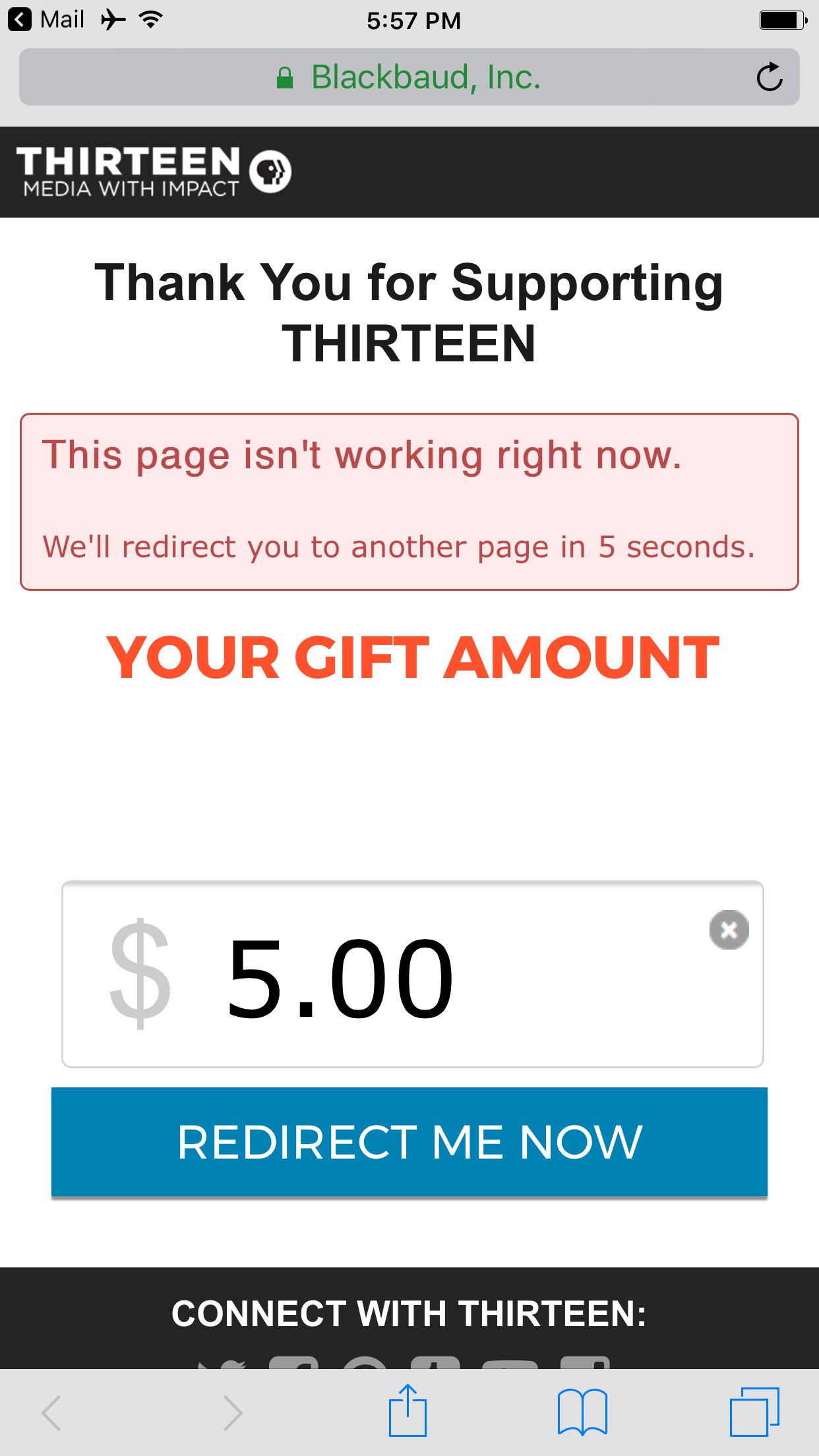Conditional Nesting syntax for XML S-tags
Options
It isn't at all clear from the documentation how to nest conditionals, particularly using the XML syntax (which I much prefer).
I'll omit the brackets and put spaces between the convio: and the thing because I'm sick of the forum software turning everything into 'surprisesmileyface' that happens whenever you do "convio: op".
I have a convio:choose block. I need to test for both dc:transactionID nempty AND dc:isGiftAmountGreaterThan:60 true -- both conditions need to be true for me to do my desired output.
Should it look like this?
convio: choose
convio: when test="nempty"
convio: op convio: session name="120" param="dc:transactionID" /convio: session /convio: op
convio: then
convio: when test="true"
convio: op convio: session name="120" param="dc:isGiftAmountGreaterThan:60" /convio: session /convio: op
convio: then
Print out the thing I want to print out
/convio: then
/convio: when
/convio: then
/convio: when
/convio: choose
BTW, it would be really awesome if there were some way to group conditionals with 'and'.
Also related, "isGiftAmountGreaterThan" doesn't seem to actually be documented other than as an example in the S-Tag reference. I'm assuming that the number value is a dollar amount. I sure hope it is.
I'll omit the brackets and put spaces between the convio: and the thing because I'm sick of the forum software turning everything into 'surprisesmileyface' that happens whenever you do "convio: op".
I have a convio:choose block. I need to test for both dc:transactionID nempty AND dc:isGiftAmountGreaterThan:60 true -- both conditions need to be true for me to do my desired output.
Should it look like this?
convio: choose
convio: when test="nempty"
convio: op convio: session name="120" param="dc:transactionID" /convio: session /convio: op
convio: then
convio: when test="true"
convio: op convio: session name="120" param="dc:isGiftAmountGreaterThan:60" /convio: session /convio: op
convio: then
Print out the thing I want to print out
/convio: then
/convio: when
/convio: then
/convio: when
/convio: choose
BTW, it would be really awesome if there were some way to group conditionals with 'and'.
Also related, "isGiftAmountGreaterThan" doesn't seem to actually be documented other than as an example in the S-Tag reference. I'm assuming that the number value is a dollar amount. I sure hope it is.
Tagged:
0
Comments
-
Why test for the transaction at all? If you're already returning an empty result for gifts below $60, wouldn't that cover your missing transactions?
Page 131 of the S-Tags PDF documentation does have a list of different objects (at least, the copy I have does). Just do a search for "S120 Display Application Objects". I'd recommend creating a test page and just trying different options.
I haven't tested this, but another forum post said you can nest conditionals by adding a second "choose" tag. So, it'd be:
convio: choose
convio: when title="TID Exists" test="nempty"
convio: op
convio: session name="120" param="dc:transactionID" /convio: session
/convio: op
convio: then
convio: choose
convio: when title="Gift 60" test="true"
convio: op
convio: session name="120" param="dc:isGiftAmountGreaterThan:60" /convio: session
/convio: op
convio: then
Print the thing
/convio: then
/convio: when
/convio: choose
/convio: then
/convio: when
/convio: choose
For what it's worth, that same huge block of code looks like this in bracket format...
[[?
x[[E130:[[S120:dc:transactionID]] 0 >]]x x[[E130:[[S120:dc:GiftAmount]] 60 >]]x ::
x1x x1x ::
Print the thing ::
]]
Folks seem to prefer bracket syntax, especially if you're nesting conditionals. XML is already verbose, and only gets crazier when the logic is complicated. Unless you need to make a WYSIWYG representation of your logic, bracket is a lot more concise and easier to read.
In general, syntax is just...
[[? xIFx :: xFOOx :: TRUE :: FALSE ]]
...AND conditionals can be done by doubling-up on your test conditions...
[[? xIF(1)xIF(2)x :: xFOOxBARx :: AND_TRUE :: FALSE ]]
...ELSE can be done by nesting a second test inside of your FALSE result...
[[? xIFx :: xFOOx ::
IF_TRUE ::
[[? xELSEx :: xBARx :: ELSE_TRUE :: FALSE ]]
]]
Eduardo Garcia's Conditional Pal could be helpful for testing, though I haven't really played with it much. He's also got a tool for E130 (pre-processing) tags. He's got both projects on his github.0
Categories
- All Categories
- Shannon parent
- shannon 2
- shannon 1
- 21 Advocacy DC Users Group
- 14 BBCRM PAG Discussions
- 89 High Education Program Advisory Group (HE PAG)
- 28 Luminate CRM DC Users Group
- 8 DC Luminate CRM Users Group
- Luminate PAG
- 5.9K Blackbaud Altru®
- 58 Blackbaud Award Management™ and Blackbaud Stewardship Management™
- 409 bbcon®
- 2.1K Blackbaud CRM™ and Blackbaud Internet Solutions™
- donorCentrics®
- 1.1K Blackbaud eTapestry®
- 2.8K Blackbaud Financial Edge NXT®
- 1.1K Blackbaud Grantmaking™
- 527 Education Management Solutions for Higher Education
- 1 JustGiving® from Blackbaud®
- 4.6K Education Management Solutions for K-12 Schools
- Blackbaud Luminate Online & Blackbaud TeamRaiser
- 16.4K Blackbaud Raiser's Edge NXT®
- 4.1K SKY Developer
- 547 ResearchPoint™
- 151 Blackbaud Tuition Management™
- 61 everydayhero
- 3 Campaign Ideas
- 58 General Discussion
- 115 Blackbaud ID
- 87 K-12 Blackbaud ID
- 6 Admin Console
- 949 Organizational Best Practices
- 353 The Tap (Just for Fun)
- 235 Blackbaud Community Feedback Forum
- 55 Admissions Event Management EAP
- 18 MobilePay Terminal + BBID Canada EAP
- 36 EAP for New Email Campaigns Experience in Blackbaud Luminate Online®
- 109 EAP for 360 Student Profile in Blackbaud Student Information System
- 41 EAP for Assessment Builder in Blackbaud Learning Management System™
- 9 Technical Preview for SKY API for Blackbaud CRM™ and Blackbaud Altru®
- 55 Community Advisory Group
- 46 Blackbaud Community Ideas
- 26 Blackbaud Community Challenges
- 7 Security Testing Forum
- 3 Blackbaud Staff Discussions
- 1 Blackbaud Partners Discussions
- 1 Blackbaud Giving Search™
- 35 EAP Student Assignment Details and Assignment Center
- 39 EAP Core - Roles and Tasks
- 59 Blackbaud Community All-Stars Discussions
- 20 Blackbaud Raiser's Edge NXT® Online Giving EAP
- Diocesan Blackbaud Raiser’s Edge NXT® User’s Group
- 2 Blackbaud Consultant’s Community
- 43 End of Term Grade Entry EAP
- 92 EAP for Query in Blackbaud Raiser's Edge NXT®
- 38 Standard Reports for Blackbaud Raiser's Edge NXT® EAP
- 12 Payments Assistant for Blackbaud Financial Edge NXT® EAP
- 6 Ask an All Star (Austen Brown)
- 8 Ask an All-Star Alex Wong (Blackbaud Raiser's Edge NXT®)
- 1 Ask an All-Star Alex Wong (Blackbaud Financial Edge NXT®)
- 6 Ask an All-Star (Christine Robertson)
- 21 Ask an Expert (Anthony Gallo)
- Blackbaud Francophone Group
- 22 Ask an Expert (David Springer)
- 4 Raiser's Edge NXT PowerUp Challenge #1 (Query)
- 6 Ask an All-Star Sunshine Reinken Watson and Carlene Johnson
- 4 Raiser's Edge NXT PowerUp Challenge: Events
- 14 Ask an All-Star (Elizabeth Johnson)
- 7 Ask an Expert (Stephen Churchill)
- 2025 ARCHIVED FORUM POSTS
- 322 ARCHIVED | Financial Edge® Tips and Tricks
- 164 ARCHIVED | Raiser's Edge® Blog
- 300 ARCHIVED | Raiser's Edge® Blog
- 441 ARCHIVED | Blackbaud Altru® Tips and Tricks
- 66 ARCHIVED | Blackbaud NetCommunity™ Blog
- 211 ARCHIVED | Blackbaud Target Analytics® Tips and Tricks
- 47 Blackbaud CRM Higher Ed Product Advisory Group (HE PAG)
- Luminate CRM DC Users Group
- 225 ARCHIVED | Blackbaud eTapestry® Tips and Tricks
- 1 Blackbaud eTapestry® Know How Blog
- 19 Blackbaud CRM Product Advisory Group (BBCRM PAG)
- 1 Blackbaud K-12 Education Solutions™ Blog
- 280 ARCHIVED | Mixed Community Announcements
- 3 ARCHIVED | Blackbaud Corporations™ & Blackbaud Foundations™ Hosting Status
- 1 npEngage
- 24 ARCHIVED | K-12 Announcements
- 15 ARCHIVED | FIMS Host*Net Hosting Status
- 23 ARCHIVED | Blackbaud Outcomes & Online Applications (IGAM) Hosting Status
- 22 ARCHIVED | Blackbaud DonorCentral Hosting Status
- 14 ARCHIVED | Blackbaud Grantmaking™ UK Hosting Status
- 117 ARCHIVED | Blackbaud CRM™ and Blackbaud Internet Solutions™ Announcements
- 50 Blackbaud NetCommunity™ Blog
- 169 ARCHIVED | Blackbaud Grantmaking™ Tips and Tricks
- Advocacy DC Users Group
- 718 Community News
- Blackbaud Altru® Hosting Status
- 104 ARCHIVED | Member Spotlight
- 145 ARCHIVED | Hosting Blog
- 149 JustGiving® from Blackbaud® Blog
- 97 ARCHIVED | bbcon® Blogs
- 19 ARCHIVED | Blackbaud Luminate CRM™ Announcements
- 161 Luminate Advocacy News
- 187 Organizational Best Practices Blog
- 67 everydayhero Blog
- 52 Blackbaud SKY® Reporting Announcements
- 17 ARCHIVED | Blackbaud SKY® Reporting for K-12 Announcements
- 3 Luminate Online Product Advisory Group (LO PAG)
- 81 ARCHIVED | JustGiving® from Blackbaud® Tips and Tricks
- 1 ARCHIVED | K-12 Conference Blog
- Blackbaud Church Management™ Announcements
- ARCHIVED | Blackbaud Award Management™ and Blackbaud Stewardship Management™ Announcements
- 1 Blackbaud Peer-to-Peer Fundraising™, Powered by JustGiving® Blogs
- 39 Tips, Tricks, and Timesavers!
- 56 Blackbaud Church Management™ Resources
- 154 Blackbaud Church Management™ Announcements
- 1 ARCHIVED | Blackbaud Church Management™ Tips and Tricks
- 11 ARCHIVED | Blackbaud Higher Education Solutions™ Announcements
- 7 ARCHIVED | Blackbaud Guided Fundraising™ Blog
- 2 Blackbaud Fundraiser Performance Management™ Blog
- 9 Foundations Events and Content
- 14 ARCHIVED | Blog Posts
- 2 ARCHIVED | Blackbaud FIMS™ Announcement and Tips
- 59 Blackbaud Partner Announcements
- 10 ARCHIVED | Blackbaud Impact Edge™ EAP Blogs
- 1 Community Help Blogs
- Diocesan Blackbaud Raiser’s Edge NXT® Users' Group
- Blackbaud Consultant’s Community
- Blackbaud Francophone Group
- 1 BLOG ARCHIVE CATEGORY
- Blackbaud Community™ Discussions
- 8.3K Blackbaud Luminate Online® & Blackbaud TeamRaiser® Discussions
- 5.7K Jobs Board

